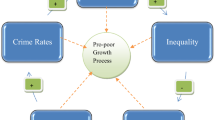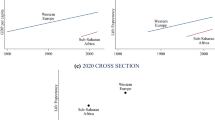Abstract
The gap between white and Hispanic poverty has remained stable for decades despite dramatic changes in the size and composition of the two groups. The gap, however, conceals crucial differences within the Hispanic population whereby some leverage education and smaller families to stave off poverty while others facing barriers to citizenship and English language acquisition face particularly high rates. In this paper, we use Decennial Census and American Community Survey data to examine poverty rates between Hispanic and non-Hispanic, white heads of household. We find the usual suspects stratify poverty risks: gender, age, employment, education, marital status, family size, and metro area status. In addition, Hispanic ethnicity has become a weaker indicator of poverty. We then decompose trends in poverty gaps between racial and ethnic groups. Between 1980 and 2010, poverty gaps persisted between whites and Hispanics. We find support for a convergence of advantages hypothesis and only partial support (among Hispanic noncitizens and Hispanics with limited English language proficiency) for a rising disadvantages hypothesis. Poverty-reducing gains in educational attainment alongside smaller families kept white–Hispanic poverty gaps from rising. If educational attainment continues to rise and family size drops further, poverty rates could fall, particularly for Hispanics who still have lower education and larger families, on average. Gains toward citizenship and greater English language proficiency would also serve to reduce the Hispanic–white poverty gap.

Similar content being viewed by others
References
Amuedo-Dorantes, C., & Antman, F. (2016). Can authorization reduce poverty among undocumented immigrants? Evidence from the Deferred Action for Childhood Arrivals program. Economics Letters, 147, 1–4.
Amuedo-Dorantes, C., Arenas-Arroyo, E., & Sevilla, A. (2016). Immigration enforcement and childhood poverty in the United States. IZA Discussion Paper No. 10030. https://ssrn.com/abstract=2807268.
Aponte, R. (1991). Urban Hispanic poverty: Disaggregations and explanations. Social Problems, 38(4), 516–528.
Bean, F. D., Feliciano, C., Lee, J., & Van Hook, J. (2009). The new U.S. immigrants: How do they affect our understanding of the African American experience? The ANNALS of the American Academy of Political and Social Science, 621(1), 202–220.
Census Bureau. (2017). How the Census Bureau measures poverty. Suitland: Census Bureau.
Couch, K., & Daly, M. C. (2002). Black-white wage inequality in the 1990s: A decade of progress. Economic Inquiry, 40(1), 31–41.
Couch, K., & Fairlie, R. (2010). Last hired, first fired? Black–white unemployment and the business cycle. Demography, 47(1), 227–247.
Douglas, K. M., & Saenz, R. (2008). “No Phone, No Vehicle, No English, No Citizenship”: The Vulnerability of Mexican Immigrants in the United States. In A. Hattery, D. Embrick, & E. Smith (Eds.), Globalization and America: Race, human rights and inequality (pp. 161–180). Lanham, MD: Rowman and Littlefield.
Fairlie, R. (2006). An extension of the Blinder-Oaxaca decomposition technique to logit and probit models. Institute for the Study of Labor (IZA). Retrieved from http://ftp.iza.org/dp1917.pdf.
Firebaugh, G., & Farrell, C. R. (2016). Still large, but narrowing: The sizable decline in racial neighborhood inequality in Metropolitan America, 1980–2010. Demography, 53(1), 139–164.
Garcia, G. (2011). Mexican American and immigrant poverty in the United States. The Springer series on demographic methods and population analysis. New York, NY: Springer.
Iceland, J. (1997). Urban labor markets and individual transitions out of poverty. Demography, 34(3), 429–441.
Iceland, J. (2003). Why poverty remains high: The role of income growth, economic inequality, and changes in family structure, 1949–1999. Demography, 40(3), 499–519.
Iceland, J., & Wilkes, R. (2006). Does socioeconomic status matter? Race, class, and residential segregation. Social Problems, 53(2), 248–273.
Jann, B. (2008). The Blinder-Oaxaca decomposition for linear regression models. The Stata Journal, 8(4), 453–479.
Johnson, K. M., Schaefer, A., Lichter, D. T., & Rogers, L. T. (2014). The increasing diversity of America’s youth. Durham, NH: Carsey School of Public Policy. Retrieved from http://scholars.unh.edu/carsey/212.
Kim, C. (2010). Decomposing the change in the wage gap between white and black men over time, 1980–2005: An extension of the Blinder-Oaxaca decomposition method. Sociological Methods & Research, 38(4), 619–651.
Kohler, U., Karlson, K. B., & Holm, A. (2011). Comparing coefficients of nested nonlinear probability models. Stata Journal, 11(3), 420–438.
Kossoudji, S. A., & Cobb-Clark, D. A. (2002). Coming out of the shadows: Learning about legal status and wages from the legalized population. Journal of Labor Economics, 20(3), 598–628.
Lichter, D. T., Parisi, D., & Taquino, M. C. (2012). The geography of exclusion: Race, segregation, and concentrated poverty. Social Problems, 59(3), 364–388.
Lopez, M. J. (2013). Poverty among Hispanics in the United States. In M. T. Mora & A. Davila (Eds.), The economic status of the hispanic population: Selected essays (pp. 49–64). Charlotte, NC: Information Age Publishing.
Massey, D. S., & Eggers, M. L. (1990). The ecology of inequality: Minorities and the concentration of poverty, 1970–1980. American Journal of Sociology, 95(5), 1153–1188.
Massey, D. S., & Pren, K. A. (2012a). Origins of the new Latino underclass. Race and Social Problems, 4(1), 5–17.
Massey, D. S., & Pren, K. A. (2012b). Unintended consequences of US immigration policy: Explaining the post-1965 surge from Latin America. Population and Development Review, 38(1), 1–29.
Mattingly, M. J., & Pedroza, J. M. (2015). “Why isn’t the hispanic poverty rate rising?” Pathways: A Magazine on Poverty, Inequality, and Social Policy (Spring). Stanford Center on Poverty and Inequality.
Orrenius, P., & Zavodny, M. (2013). Trends in poverty and inequality among Hispanics. In R. S. Rycroft (Ed.), The economics of inequality, poverty, and discrimination (pp. 217–235). Santa Barbara, CA: Praeger.
Passel, J. S., & Cohn, D. (2009). A portrait of unauthorized immigrants in the United States. Washington, DC: Pew Research Center. Retrieved from http://www.pewhispanic.org/files/reports/107.pdf.
Ruggles, S., Genadek, K., Goeken, R., Grover, J., & Sobek, M. (2015). Integrated public use microdata series: Version 6.0 [Machine-readable database]. Minneapolis, MN: University of Minnesota.
Rugh, J. S., & Massey, D. S. (2014). Segregation in post-civil rights America. Du Bois Review: Social Science Research on Race, 11(2), 205–232.
Siordia, C., & Leyser-Whalen, O. (2014). Mexican Americans’ lucky few and baby boom cohorts: How is relative cohort size related to the likelihood of being out-of-poverty? Sociological Focus, 47(3), 163–173.
Sullivan, D. H., & Ziegert, A. L. (2008). Hispanic immigrant poverty: Does ethnic origin matter? Population Research and Policy Review, 27(6), 667–687.
Taylor, P., Lopez, M. H., Passel, J. S., & Motel, S. (2011). Unauthorized immigrants: Length of residency, patterns of parenthood. Washington, DC: Pew Hispanic Center.
Tienda, M., & Lii, D.-T. (1987). Minority concentration and earnings inequality: Blacks, Hispanics, and Asians compared. American Journal of Sociology, 93(1), 141–165.
Tran, V. C., & Valdez, N. M. (2017). Second-generation decline or advantage? Latino assimilation in the aftermath of the great recession. International Migration Review, 51(1), 155–190.
Van Hook, J., Brown, S. L., & Kwenda, M. N. (2004). A decomposition of trends in poverty among children of immigrants. Demography, 41(4), 649–670.
Waldinger, R. D. (1999). Still the promised city? African-Americans and new immigrants in postindustrial New York. Cambridge, MA: Harvard University Press.
Wilson, W. J. (2015). New perspectives on the declining significance of race: A rejoinder. Ethnic and Racial Studies, 38(8), 1278–1284.
Young, J. R. (2012). Underemployment in urban and rural America, 2005-2012. Durham, NH: Carsey Institute, University of New Hampshire. Retrieved from http://scholars.unh.edu/carsey/179.
Author information
Authors and Affiliations
Corresponding author
Appendix : Blinder-Oaxaca Decomposition Models
Appendix : Blinder-Oaxaca Decomposition Models
Hispanic–white poverty | ||||
|---|---|---|---|---|
1980 | 1990 | 2000 | 2010 | |
Gap | 12.4% | 13.5% | 12.7% | 11.6% |
Change in Hispanic poverty | ||||
|---|---|---|---|---|
Variable | 1980 | 1990 | 2000 | 2010 |
Speaks English not well or not at all | 0.00945 | 0.00889 | 0.01900 | 0.02909 |
Foreign-born, naturalized citizen | − 0.00192 | − 0.00173 | 0.00086 | 0.00300 |
Foreign-born, noncitizen | 0.00773 | 0.00901 | 0.00984 | 0.00655 |
Professional occupation | 0.00382 | 0.00363 | 0.00290 | 0.00334 |
Working in a typical “immigrant job” | − 0.00159 | n.s. | 0.00032 | 0.00288 |
Number of adult workers in family | − 0.00533 | − 0.00983 | − 0.00507 | − 0.01326 |
Head employed < 50 weeks last year | 0.00442 | 0.00602 | 0.00671 | − 0.00673 |
Female | 0.00035 | 0.00029* | 0.00009 | 0.00036 |
25–34 years old | 0.00224 | 0.00404 | 0.00299 | 0.00332 |
35–44 years old | 0.00066 | 0.00108 | 0.00074 | 0.00073 |
45–54 years old | 0.00033 | 0.00025 | − 0.00039 | − 0.00019 |
65–74 years old | 0.00454 | 0.00620 | 0.00606 | 0.00608 |
75 + years old | 0.00210 | 0.00562 | 0.01007 | 0.01031 |
Less than high school | 0.01596 | 0.02405 | 0.02676 | 0.02909 |
High school, 12 years | − 0.00061 | − 0.00083 | − 0.00086 | − 0.00056 |
College, 4 + years | 0.00076 | 0.00186 | 0.00265 | 0.00392 |
Married, spouse absent | 0.00185 | 0.00165 | 0.00188 | 0.00291 |
Separated | 0.00533 | 0.00484 | 0.00398 | 0.00514 |
Divorced | 0.00061 | n.s | − 0.00141 | − 0.00258 |
Widowed | − 0.00349 | − 0.00358 | − 0.00248 | − 0.00258 |
Never married, single | 0.00058 | 0.00132 | 0.00171 | 0.00502 |
No children under age 18 | 0.00045 | 0.00334 | 0.00295 | 0.00539 |
Two children under age 18 | 0.00116 | 0.00215 | 0.00215 | 0.00233 |
Three children under age 18 | 0.01030 | 0.01193 | 0.00965 | 0.00873 |
Presence of a child under age 5 | 0.00276 | 0.00205 | 0.00175 | 0.00171 |
Not in metro area | − 0.00130 | − 0.00400 | − 0.00114 | − 0.00115 |
Metro area, central city | − 0.00588 | − 0.00318 | − 0.00195 | − 0.00140 |
Other metro | 0.00169 | 0.00052 | 0.00082 | 0.00029 |
Metro status not identifiable | 0.00052 | 0.00069 | − 0.00055 | − 0.00063 |
Totala | 5.7% | 7.6% | 10.0% | 10.1% |
Proportion of gap explained | 46% | 56% | 79% | 87% |
Rights and permissions
About this article
Cite this article
Mattingly, M.J., Pedroza, J.M. Convergence and Disadvantage in Poverty Trends (1980–2010): What is Driving the Relative Socioeconomic Position of Hispanics and Whites?. Race Soc Probl 10, 53–66 (2018). https://doi.org/10.1007/s12552-017-9221-1
Published:
Issue Date:
DOI: https://doi.org/10.1007/s12552-017-9221-1




